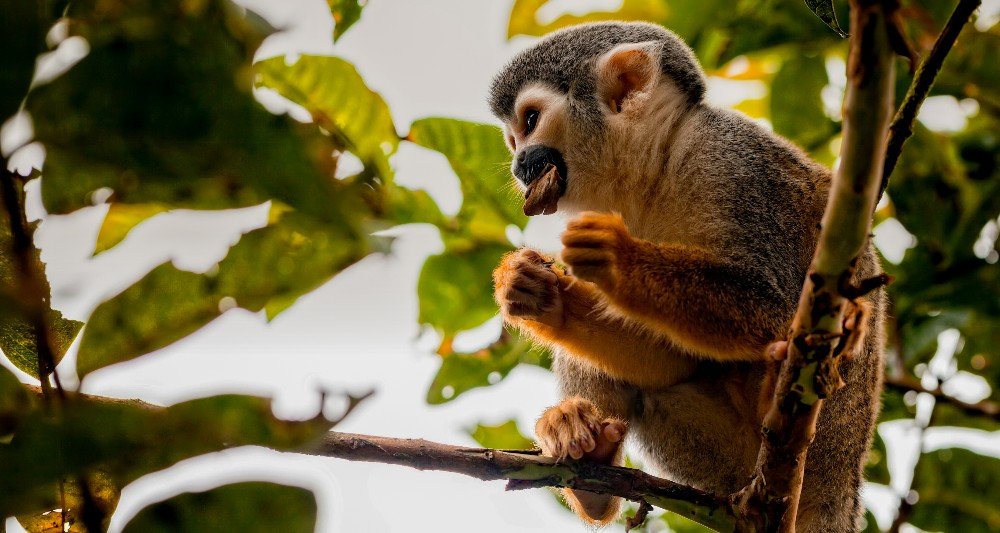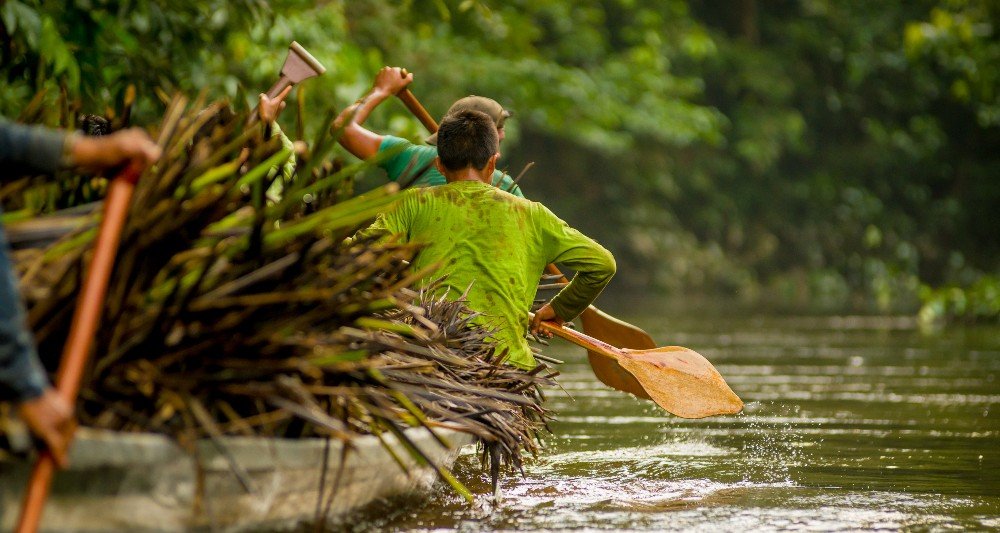Explore The Amazon in Ecuador: 6 Things to Know About Yasuni National Park
Yasuni National Park lies deep in the Amazonian jungle in Ecuador, South America. This untouched wonderland is teeming with life, boasting an impressive variety of 650 tree species and a remarkable array of mammals, birds and amphibians.
A glorious natural paradise, Yasuni National Park is a recognized UNESCO biosphere reserve. Wild and unspoilt, many choose to visit the site while exploring the Galapagos Islands. After all, it’s only natural that wildlife lovers going to the islands are also enticed by the idea of ticking off another of the most biologically diverse places on earth.
For those of you considering a visit to Yasuni as part of a Galapagos Islands adventure or as a standalone trip, we have put together a guide on everything you need to know about the park ahead of your vacation, from where it is to what you can do there.
Where is Yasuni National Park Located?
Yasuni National Park is located near the equator in the Amazon Basin, nestled at the base of the Andes mountains that run through the center of Ecuador. It covers an area of 9,823 square kilometers very close to Peru and is situated approximately 200 miles from Quito.
The park is bordered by the Napo River to the north and the Curarylo River to the south. Inside its boundaries, you'll find an intricate labyrinth of tropical woodlands and numerous rivers, such as the Tivacundo, Tiputini, Yasuni, Nashiño, Cononaco and Tihuino.
The site has a low elevation, between 200 and 300 meters above sea level, resulting in a hot, humid climate.
Yasuni National Park: How to Get There
When planning your Ecuadorian adventure, one of the key things to consider is how to get to Yasuni National Park. Given its remote location, reaching this destination is not quite as simple as hopping on a train.
One of the easiest ways to get to Yasuni National Parks is by taking a flight from Quito to the oil frontier town of Puerto Francisco de Orellana, often referred to as Coca. From there, you can embark on a scenic two-and-a-half-hour boat ride along the Napo River.
Alternatively, you can take an 8-10 hour bus from Quito to Coca. It's important to note that tourists require permission to enter the park. To make getting to Yasuni National Park as easy as possible, you may consider booking an Amazon tour.
This way, you'll not only explore Yasuni but also have the opportunity to cruise to many of the other best places to visit in Ecuador, all without facing the complexities that come with handling the logistics on your own.
Why is Yasuni National Park So Special?
Located in Ecuador, a country renowned for being home to extraordinary natural sites such as the Galapagos Islands, you might be curious about what makes Yasuni National Park so special. Much like the islets, the park ranks among the most biologically diverse places on Earth.
Within Yasuni, you will find a magnificent range of animals and landscapes. The park is home to over 4,000 plant species which flourish in its spectacular tropical climate. The thriving vegetation feeds the park’s incredible wildlife residents, which include yellow-bellied spider monkeys, giant anteaters and sloths.
In fact, Yasuni is one of the richest areas on the planet for the diversity of bird, tree, bat, mammal and amphibian species. Despite covering less than 0.15% of the Amazon Basin, it harbors approximately 33% of all reptile and amphibian species found in the region.
One of the park’s most remarkable feats is that many of the creatures inhabiting its landscape cannot be found anywhere else on the planet. Yasuni boasts nearly 50 endemic species, spanning amphibians, reptiles, birds and mammals.
Furthermore, the park is home to 400-720 regional endemic plant species. In essence, Yasuni provides a remarkable window into a world of flora and fauna that exist exclusively within its borders.
The geographical location of Yasuni plays a pivotal role in nurturing its diverse wildlife and plant life. It sits at the convergence of three distinct ecosystems: within the Amazon basin, close to the equator and at the foothills of the Andes mountain range.
Yet, it’s not just the landscape and wildlife that make Yasuni so special. The site also protects sections of the Waorani nationality territory. The Waourani people are a hunter-gatherer community who rely on the primary forests for their very survival.
What Animals Can You See in Yasuni National Park?
Yasuni is home to a glorious range of animals. Here you will find more frog and toad species than in the whole of North America, over 204 species of mammals and 121 types of reptiles. Additionally, the park is home to more insect species than any other forest in the world.
While the landscape is teeming with wildlife, certain creatures in particular tend to capture the hearts of its visitors. Some of the park's most beloved residents include giant armadillos, black caiman, white-bellied spider monkeys and giant otters.
In the realm of primates, the landscape is inhabited by tayras, ocelots and jaguars. Yasuni National Park also boasts over 596 species, representing a third of the total number of native bird species in the Amazon.
Notable avian inhabitants include yellow-billed cuckoos, rufous-headed woodpeckers and swallow-winged puffbirds. With such a dazzling wealth of wildlife to observe it’s no wonder why Yasuni is widely regarded as the best national park in Ecuador.
What To Do and See in Yasuni National Park
As the largest national park in Ecuador, it is impossible to find yourself short of things to see and do in Yasuni National Park. We have shared some of the top attractions and activities to check off while visiting this magnificent landscape.
Wildlife Watching
An animal lover’s paradise, wildlife watching is often hailed as the best thing to do in Yasuni National Park. An expert guide can lead you through the unspoilt landscape, attentively tracking even the slightest wildlife movements to ensure you reach the finest viewing spots.
Get ready to encounter a fascinating variety of creatures during your adventure, from bats to monkeys and tapirs to anteaters.
Bird Watching
Home to an extraordinary abundance of birds, the skies above Yasuni are bustling with vibrant winged species. Be ready to observe a stunning array of exotic, colorful and unique creatures.
As you explore the park, keep an eye out for hummingbirds, tinamous and hoatzins at ground level. Along the water's edge, watch for the striking plumage of kingfishers, as well as flycatchers and waders.
Rainforest Hiking
Exploring Yasuni National Park on two feet is one of the best ways to uncover its incredible wealth of plant life and jungle creatures. In the company of a guide, you can embark on a hiking adventure, discovering all of the edible and medicinal plants growing in the area.
Additionally, this journey will enable you to uncover the secrets of the landscape, delve into its history and gain insights into the dynamic relationship between its vegetation and wildlife.
Visit an Authentic Kichwa Family
Visiting an authentic Kichwa family is one of the most unique things to do in Yasuni National Park. To do this, you can journey to the banks of the Napo River, where you'll be greeted by members of the local community who will share valuable insights into what life is like in this extraordinary part of the world.
When Should You Visit Yasuni National Park?
You may be wondering when is the prime time to visit the best Amazonian national park ahead of your trip. This area of the Amazon has three distinct seasons: wet, dry and shoulder. These come with varying weather conditions, so your experience can be quite different depending on the month you decide to go.
The rainy season spans from March to July. While there are heavy showers during this period, it's important to note that it doesn't rain incessantly every day. Visitors during the rainy season will witness the rivers at their highest water levels which provides the perfect conditions for canoe trips.
Those heading to Yasuni during this period will also be able to enjoy relatively comfortable temperatures, averaging around 75° Fahrenheit.
The dry season, on the other hand, begins in December and lasts until March. Although there is less rain during this time, you still encounter some precipitation - after all, you're in the rainforest!
The key advantage of visiting Yasuni National Park during the dry season is that rain is less likely to interrupt activities. However, this comes at the cost of lower river levels, which can pose challenges for canoe navigation.
Finally, the in-between, or "shoulder" season, falls between July and December. Weather during this period can be more unpredictable, featuring a mix of rain and sunshine. Average temperatures hover around 77° Fahrenheit.
None of these seasons guarantees a better experience than the others; rather, each promises a unique and equally remarkable experience.
When deciding when to visit Yasuni National Park, it's essential to consider your priorities for your trip. You may value pleasant temperatures, optimal wildlife viewing conditions or minimal rainfall. Taking these factors into account will help you determine the best time to visit Yasuni National Park for you.
Summary
As you can see, visiting the largest national park in Ecuador promises a spectacular adventure. Nestled deep in the Amazonian jungle of Ecuador, Yasuni offers an unspoiled paradise filled with a remarkable variety of wildlife and lush landscapes.
This magnificent biosphere reserve makes for a fantastic place to explore, either as a vacation in itself or as a combined trip to the Galapagos Islands.
Want to explore Yasuni National Park while visiting the Galapagos Islands? Check out our Amazon and Galapagos Cruise that takes you to each of these natural utopias. Explore our range of yacht and tour packages to find the perfect itinerary for your adventure or contact us today to jump straight to planning your trip.





